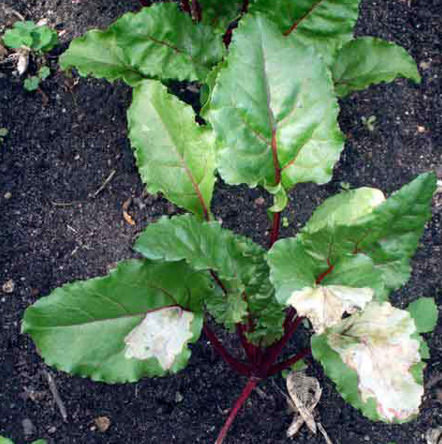Leafminers: What They Are and How to Control Them
By Ecology Action Staff

Leafminers have damaged the leaves of this beet plant.
PHOTO CREDIT: www.extension.umn.edu/garden/diagnose/plant/vegetable/beet/leavesspots.html
Leafminers can affect beans, beets, cabbage, chard, lettuce, peppers, tomatoes, and many other vegetables. They also attack ornamentals, especially chrysanthemum and nasturtium.
The larvae of leafminers tunnel between the leaf surfaces, creating hollow, curved mines. While not always life-threatening to the plant, this gives the foliage an unattractive appearance. If mature plants experience extensive leaf mining, it may cause leaves to dry, resulting in sunburned fruit, lowering the yield and quality. Serious infestations may cause plants to die.
Adults are small black or black and yellow flies, which are not often seen. The eggs are white and cylindrical and hatch into larvae that are pale green. Due to their relatively short life cycle, several generations can occur each year.
Prevention
- To keep adult flies from laying eggs on your plants, you can erect a floating row cover, i.e. fine-meshed netting, cheesecloth or a similar material that allows sunlight and rain in but keeps insects out. Install a floating row cover in areas that haven't had leafminer problems for at least one year because pupae can overwinter near plants prone to leafmining, producing adults under the row cover. If there are lots of pests, keep crops covered all season.
- Lamb's quarters and dock are natural hosts for beet leafminers. Remove any nearby plants that might breed leafminers.
Control
If leafminers have become established in your garden, they can be controlled as follows:
- Prune damaged leaves by handpicking. Be sure to destroy any mined leaves. Do not put them in the compost pile. The insects may breed there and be reintroduced to the garden when the compost is applied.
- Remove any egg clusters as soon as they are visible.
- Consider spraying neem oil or other natural pesticide.
- Be sure not to plant a crop in the same family where the previous crop had leafminers.
Sources:
www.weekendgardener.net/garden-pests/leafminers-090909.htm
www.extension.umn.edu/garden/insects/find/leafminers-in-home-vegetable-gardens/
top | Newsletter Home | Article Index | Archive

|



